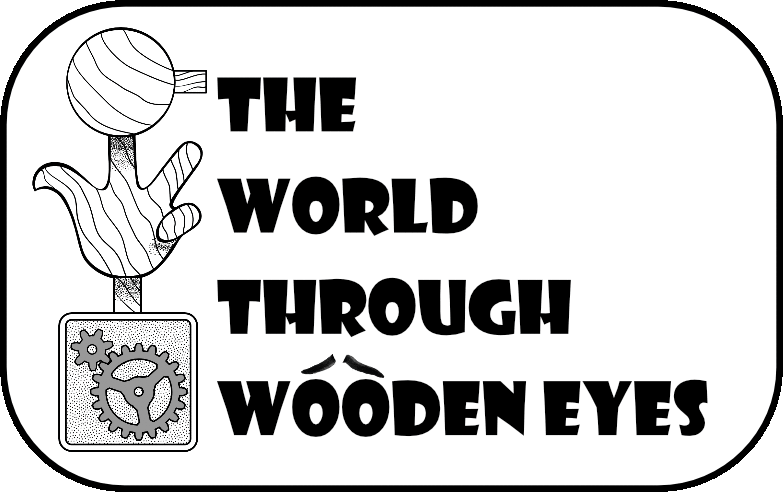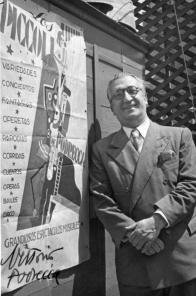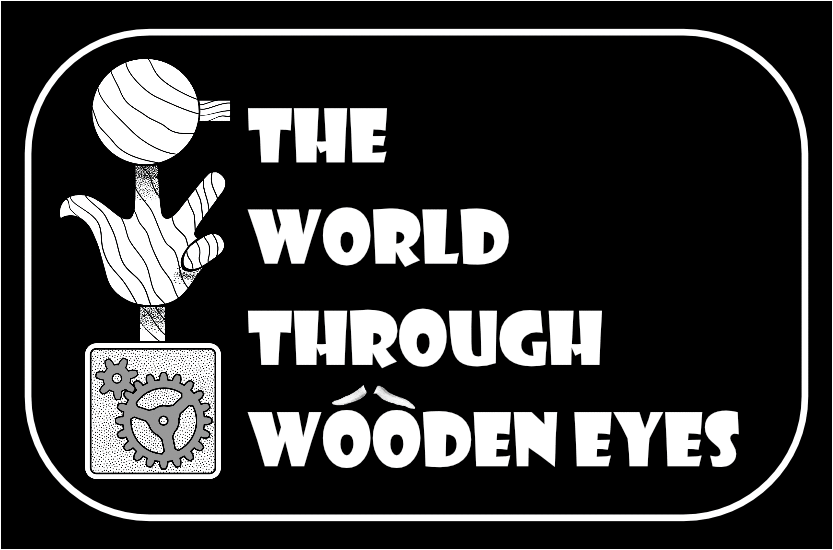NAVIGATION
SOCIAL
CONTACT
e-mail: info@theworldthroughwoodeneyes.co.uk

Podrecca’s
Piccoli
was
recognised
as
the
most
spectacular,
innovative
and
inspirational
marionette
theatre
in
the
world.
The
company
was
founded
by
Vittorio
Podrecca
in
1914,
in
Rome,
where
it
became
one
of
the
most
important
and
popular
theatres.
His
intention
was
to
develop a marionette theatre different to the puppet theatres in Italy at the time.
Podrecca
was
a
great
intellect
with
a
background
as
a
lawyer,
journalist,
impresario
and
publisher.
He
was
also
editor
of
the
arts
magazine
‘Primavera’.
He
secured
the
skills
of
some
of
the
most
distinguished
artists
of
the
time
to
create
designs
for
his
theatre,
including
Prampolini
and
Depero,
two
of
the
leading
personalities
of
The
Futurist
Movement.
The
first
theatre
production
of
the
Futurists,
‘A
Marionette
Ballet’,
with
figures
designed
by
Depero
was
performed
in Podrecca’s theatre.
His
love
of
opera
also
attracted
numerous
major
composers
to
write
original
music
for
his
productions.
Podrecca
saw
puppets
as
instruments.
Respighi
wrote
his
opera
The
Sleeping
Beauty
for
him.
Other
operas
performed
included
the
works
of
Rossini,
Donizetti,
Pergolesi,
Mozart, Purcell and Gluck. Shakespeare’s ‘The Tempest’, was also performed by the company.
In
1922
the
success
of
Podrecca’s
Piccoli
led
to
a
worldwide
tour
that
lasted
for
many
years,
travelling
through
some
thirty
countries.
The
first
major
date
was
a
lengthy
season
at
the
London
Coliseum
in
1923.
Harry
Whanslaw
was
a
regular
visitor
and
he
made
numerous
drawings
of
aspects
of
the
company
and
its
work,
and
was
much
inspired
by
what
he
saw.
The
ensuing
tour
took
the
company
to
many
parts
of
the
world,
with
one
of
the
highlights,
a
three
month season in Paris. Podrecca was awarded the prestigious Legion of Honour, in 1929.
The
company
consisted
of
some
30
staff,
including
an
orchestra,
actors
and
singers,
tons
of
equipment,
including
some
eight
hundred
puppets
and
three
hundred
stage
settings.
The
puppeteers were drawn from generations of Italian masters of the art.
Podrecca
and
his
company
was
praised
by
many
of
the
greatest
personalities
of
the
theatre
and
film,
Charlie
Chaplin
declared,
‘No
one
has
ever
enjoyed
this
charming
show
as
much
as
I
did’.
Disney
described
the
show
as,
’Pure
Magic‘.
George
Bernard
Shaw
said
that
it
was
‘preferable
to
real
live,
flesh
and
blood
actors‘,
some
of
the
personalities,
including
Garbo,
Maurice
Chevalier, Toscanini, and Josephine Baker were portrayed as marionettes in the programmes.
Podrecca
took
ideas
for
new
works
from
the
countries
that
the
company
toured
to,
but
one
of
the
most
popular
was
‘Varieties‘.
This
was
a
production
that
featured
paradise
on
operas,
portrait
figures
of
leading
personalities;
one
item
featured
Pavlov’s
‘Dying
Swan’.
It
was
the
series
of
‘fantoccini’
and
circus
and
variety
type
items
that
had
a
great
influence
on
puppeteers
in
many
parts
of
the
world,
not
the
least
the
UK,
where
the
pianist,
Maestro
Piccolovsky,
and
opera
singer,
Sinforosa
Strangolini,
with
the
heaving
bosom,
or
the
stretching
neck,
were
some
of
the
most
copied
items.
In
Podrecca’s
version,
her
neck,
as
long
as
the
figures
body,
reached
heights
on
the
excruciating
top
notes
that
led
the
stage
manager
trying
to
drag
her
off
stage with the aid of a walking stick, the failure of this, saw the stage manager running on stage, grabbing her by the neck, and running of with her.
Vittorio
Podrecca
died
in
Geneva
in
July
1959.
The
Piccoli
tried
to
survive
without
him,
and
in
1964
the
company
disbanded.
One
of
the
last
tours
was
here
in
the
UK.
It
started
at
The
Victoria
Palace,
London,
subsequent
dates
were
very
poorly
attended,
and
slowly
the
scale
of
the
company,
the
marionettes
and
the
fit-up
were
reduced.
They
frequently
played
to
as
few
as 30 audience numbers in major theatres.
I
never
met
Vittorio
Podrecca
himself,
but
I
did
become
very
friendly
with
Lia
Podrecca,
his
wife
-
a
former
West
End
singer
and
dancer
-
and
his
son
Farinelli,
manager
of
the
company.
I
well
remember
sitting
with
Lia
backstage
at
the
Victoria
Palace,
she
was
saddened
by
the
small
audiences
there,
and
said,
‘Johnny,
why
is
it,
that
for
so
many
years
we
played
to
audiences
all
over
the
world
-now
look
at
it’.
Many
hours
were
spent
watching
their
extraordinary
performances,
even
working
with
some
of
the
marionettes.
It
was
a
great
experience.
Now
in
my
collection there are numerous treasured items, including a fine photograph signed by him, and their portrait marionette of Pavlova, in one of her famous roles ‘Papilion’.
Podrecca was one of the members of the Executive Committee of UNIMA.
John Blundall.
Podrecca’s Piccoli



CONTACT
e-mail: info@theworldthroughwoodeneyes.co.uk
SOCIAL

Podrecca’s
Piccoli
was
recognised
as
the
most
spectacular,
innovative
and
inspirational
marionette
theatre
in
the
world.
The
company
was
founded
by
Vittorio
Podrecca
in
1914,
in
Rome,
where
it
became
one
of
the
most
important
and
popular
theatres.
His
intention
was
to
develop
a
marionette
theatre
different to the puppet theatres in Italy at the time.
Podrecca
was
a
great
intellect
with
a
background
as
a
lawyer,
journalist,
impresario
and
publisher.
He
was
also
editor
of
the
arts
magazine
‘Primavera’.
He
secured
the
skills
of
some
of
the
most
distinguished
artists
of
the
time
to
create
designs
for
his
theatre,
including
Prampolini
and
Depero,
two
of
the
leading
personalities
of
The
Futurist
Movement.
The
first
theatre
production
of
the
Futurists,
‘A
Marionette
Ballet’,
with
figures
designed by Depero was performed in Podrecca’s theatre.
His
love
of
opera
also
attracted
numerous
major
composers
to
write
original
music
for
his
productions.
Podrecca
saw
puppets
as
instruments.
Respighi
wrote
his
opera
The
Sleeping
Beauty
for
him.
Other
operas
performed
included
the
works
of
Rossini,
Donizetti,
Pergolesi,
Mozart,
Purcell
and
Gluck.
Shakespeare’s
‘The Tempest’, was also performed by the company.
In
1922
the
success
of
Podrecca’s
Piccoli
led
to
a
worldwide
tour
that
lasted
for
many
years,
travelling
through
some
thirty
countries.
The
first
major
date
was
a
lengthy
season
at
the
London
Coliseum
in
1923.
Harry
Whanslaw
was
a
regular
visitor
and
he
made
numerous
drawings
of
aspects
of
the
company
and
its
work,
and
was
much
inspired
by
what
he
saw.
The
ensuing
tour
took
the
company
to
many
parts
of
the
world,
with
one
of
the
highlights,
a
three
month
season
in
Paris.
Podrecca
was
awarded the prestigious Legion of Honour, in 1929.
The
company
consisted
of
some
30
staff,
including
an
orchestra,
actors
and
singers,
tons
of
equipment,
including
some
eight
hundred
puppets
and
three
hundred
stage
settings.
The
puppeteers
were
drawn
from
generations
of
Italian
masters
of
the art.
Podrecca
and
his
company
was
praised
by
many
of
the
greatest
personalities
of
the
theatre
and
film,
Charlie
Chaplin
declared,
‘No
one
has
ever
enjoyed
this
charming
show
as
much
as
I
did’.
Disney
described
the
show
as,
’Pure
Magic‘.
George
Bernard
Shaw
said
that
it
was
‘preferable
to
real
live,
flesh
and
blood
actors‘,
some
of
the
personalities,
including
Garbo,
Maurice
Chevalier,
Toscanini,
and
Josephine
Baker
were
portrayed
as
marionettes in the programmes.
Podrecca
took
ideas
for
new
works
from
the
countries
that
the
company
toured
to,
but
one
of
the
most
popular
was
‘Varieties‘.
This
was
a
production
that
featured
paradise
on
operas,
portrait
figures
of
leading
personalities;
one
item
featured
Pavlov’s
‘Dying
Swan’.
It
was
the
series
of
‘fantoccini’
and
circus
and
variety
type
items
that
had
a
great
influence
on
puppeteers
in
many
parts
of
the
world,
not
the
least
the
UK,
where
the
pianist,
Maestro
Piccolovsky,
and
opera
singer,
Sinforosa
Strangolini,
with
the
heaving
bosom,
or
the
stretching
neck,
were
some
of
the
most
copied
items.
In
Podrecca’s
version,
her
neck,
as
long
as
the
figures
body,
reached
heights
on
the
excruciating
top
notes
that
led
the
stage
manager
trying
to
drag
her
off
stage
with
the
aid
of
a
walking
stick,
the
failure
of
this,
saw
the
stage
manager
running
on
stage,
grabbing
her
by
the
neck,
and
running of with her.
Vittorio
Podrecca
died
in
Geneva
in
July
1959.
The
Piccoli
tried
to
survive
without
him,
and
in
1964
the
company
disbanded.
One
of
the
last
tours
was
here
in
the
UK.
It
started
at
The
Victoria
Palace,
London,
subsequent
dates
were
very
poorly
attended,
and
slowly
the
scale
of
the
company,
the
marionettes
and
the
fit-up
were
reduced.
They
frequently
played
to
as
few
as
30 audience numbers in major theatres.
I
never
met
Vittorio
Podrecca
himself,
but
I
did
become
very
friendly
with
Lia
Podrecca,
his
wife
-
a
former
West
End
singer
and
dancer
-
and
his
son
Farinelli,
manager
of
the
company.
I
well
remember
sitting
with
Lia
backstage
at
the
Victoria
Palace,
she
was
saddened
by
the
small
audiences
there,
and
said,
‘Johnny,
why
is
it,
that
for
so
many
years
we
played
to
audiences
all
over
the
world
-now
look
at
it’.
Many
hours
were
spent
watching
their
extraordinary
performances,
even
working
with
some
of
the
marionettes.
It
was
a
great
experience.
Now
in
my
collection
there
are
numerous
treasured
items,
including
a
fine
photograph
signed
by
him,
and
their
portrait
marionette
of
Pavlova, in one of her famous roles ‘Papilion’.
Podrecca
was
one
of
the
members
of
the
Executive
Committee
of UNIMA.
John Blundall.
Podrecca’s Piccoli


































